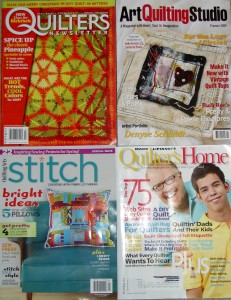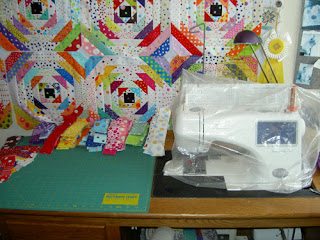Last week I went to Borders to buy some magazines for the Wellness program at work. I couldn’t help stopping by the hobbies section and picking up a few bits of inspiration.

Yes, you do see an issue of Quilter’s Newsletter Magazine in the batch. It had an article on pineapples. Despite my hiatus from my pineapple project, I still love them and couldn’t resist. One issue purchase doesn’t, however, mitigate my annoyance at their abrupt and sneaky change in publishing schedule.
In addition to the pineapples, QNM packs a lot into their issues. This issue has a lot of pictures of quilts. There is an exhibit of President Obama quilts, an article about quilting vintage tops (to quilt or not to quilt), which mostly interest me because of the wonderful photos included. There is a fun batik basket quilt as well as a Jewel Box that includes a self bordering technique. Luana Rubin also wrote an article on colors she developed for the quilting industry for the coming year and some paper piecing patterns of a bride and groom. Kaffe Fassett and Liza Prior Lucy have ‘designed’ a quilt that is included. It is a large-ish rectangle surrounded by borders. The fabrics are, of course, fabulous, but I don’t see the need for a pattern. I also didn’t read the pattern, so there must be something special I am missing. There is an interesting Christmas tree quilt pattern with some Liberated Quiltmaking type stars in one border. I, also, have to say that I do like the cheerful layout that QNM is using.
Stampington & Company has a new magazine called Art Quilting Studio. The words “premier issue’ caught my eye and I grabbed it. I haven’t been happy with Quilting Arts lately as they have mostly scrapped the techniques section and are providing only projects. Art Quilting Studio shows some avant garde pieces, has an interview with Denyse Schmidt and lots of detail shots. The colors appeal to me, though the layout colors are more subdued that the issue of QNM mentioned above. I liked the Layered Collages of Art article by DJ Pettitt, because the faces in her pieces are very appealing.
I also bought a copy of Stitch magazine. This is a product of the Quilting Arts family of magazines. I only bought it because I fell in love with the pillow on the cover. I glanced through it quickly and thought that was the only thing I would like in it. Later, I sat down at a cafe and looked through it page by page and found a few other things I liked.
There is an article about thread. I find thread to be completely mystifying so the more information the better, as far as I am concerned. That article talks about different types of stitching as well as the qualities of different threads.
The article with the log cabin pillow also has a round pillow called the Pi Pillow and a pillow called the Fabulous Floor Pillow. I think I might try one of those as well. I also saw a tote bag, which has possibilities without the fog grey bottom and an apron which might make a nice gift. There is a glossary of sewing terms, which I might dismiss quickly, except the stitch glossary which shows the reader how to make arious stitches.
Quilter’s Home also came in the mail recently. Mark is on the cover, as usual, with his son, Evan, which is not usual. I have enjoyed Mark’s story of his son in previous issues. The patterns in this issue are very ordinary. He recommends buying all the books he reviews so he must be getting pressure not to pan quilt books. He has the decorating section, which I can take or leave. I think the edge is wearing off of Mark’s style. It could be that CK Media is making him tone it down.
Fortunately, there is still thr3fold journal! This journal really makes me happy when I read it. It makes me really happy when the package comes! I know it sounds dumb to say that, but I feel an actual uplifting of my spirit when I read the articles. The style is quietly confident. The colors are cheerful and interesting. The articles are well written. While I may not want to make every project or try every technique, I enjoy reading about their process. I also feel that I can try their projects if I follow their directions. I have written about this journal before and think that I will stop liking it, but having received issue 4 I still feel excited when I open an issue. I am looking forward to issue 5 already!






 Rearrange the furniture. Saying, “What if I put the desk over there?” and doing so, can give you a fresh perspective on your room and your art.
Rearrange the furniture. Saying, “What if I put the desk over there?” and doing so, can give you a fresh perspective on your room and your art.





